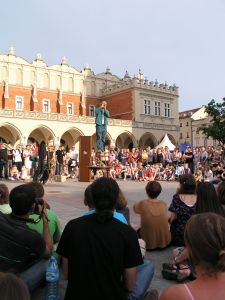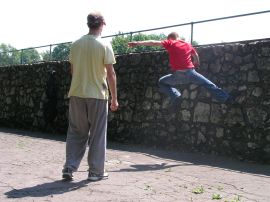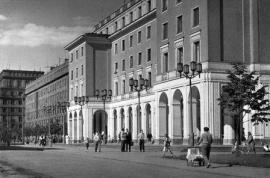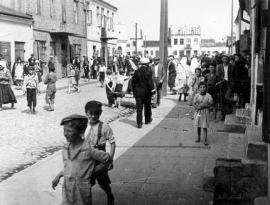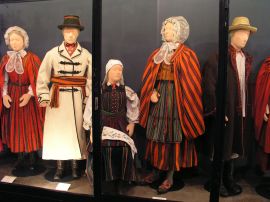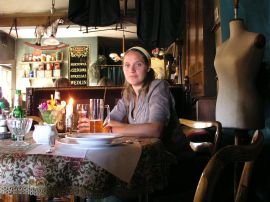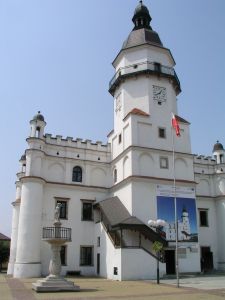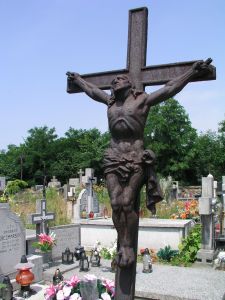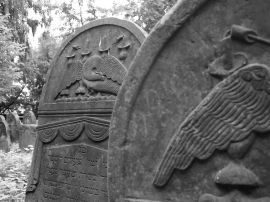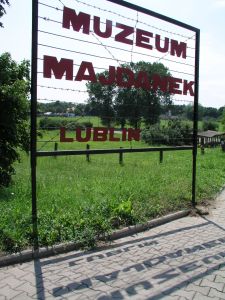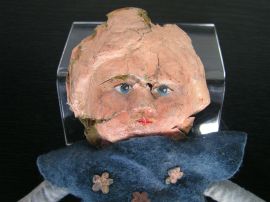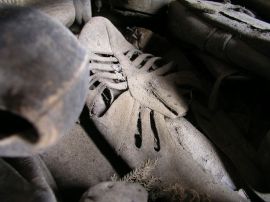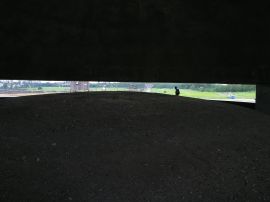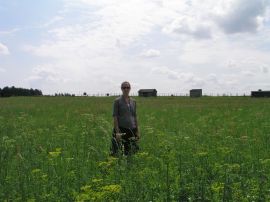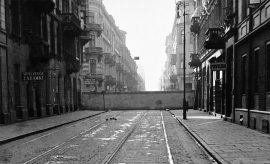This Is Not a Postcard
Tales of 2 people on 3 continentsArchive for Parkour
Chapter X. In which the author travels to her ancestral homeland and subsequently finds parallels between Warsaw and San Antonio, Texas
James and I are leaving Poland on a train – an experience that many of many of my forebears and fellow Jews did not have the privilege of enjoying. The dust that was their flesh and bones now lies heaped in piles at Holocaust museums and scattered in nameless fields and undiscovered ditches.
I leave feeling depressed, angry and exhausted. But most of all I leave feeling disappointed.
Disappointed in humanity and the ways in which it has not proven itself worthy of life on this beautiful planet. Disappointed in the ways in which it continues to fall short.
Let me back up a little, though, before I get into the disappointing bits.
I. Old and Nowa (New) Krakow
The most breathtaking central square I’ve ever seen is in the Old Town in Krakow. It is simply magical.
We ended up spending quite a lot of time there – meeting up with friends, joining local walking tours, viewing various street theater performances.
Most of the street theater was complete garbage, unfortunately – there was a festival going on that didn’t seem particularly adept at choosing quality acts.
Whenever I got bored or irritated during any of the performances, however, I just let my gaze drift over to the horses and carriages, cafes, medieval buildings, towers, birds, clouds. I felt truly inspired.
One of the things that is compelling about the squares in Poland is that they feature buildings in their centers. So the square is really a ring of pedestrian traffic around a central structure. This creates a more intimate atmosphere around its corners. We also saw this in Lublin. It’s sort of like partitioning areas in a restaurant, making it cozier. Poland’s squares feel quite cozy, despite their ornate architecture and grand scale.
Another thing we did in the square was help our host Andrzej get set up for his “living statue” act outside the Basilica.
You may have seen these folks before; they dress up to look like a statue (e.g. the Statue of Liberty), and then they stand on a podium in a popular tourist location and freeze.
Passers by throw coins in their hats, sometimes posing to take a photo. This cracks me up because everyone is definitively frozen in a photo – not just the performer. It’s only in dynamic time and space that you are able to appreciate the artist’s oeuvre, if you could go so far as to call it that.
Andrzej is also great at moving through space; he leads “parkour” workshops for street kids several times per week.
Parkour is a sort of sport or physical art form that involves moving through an urban landscape in the most efficient and elegant way possible. The city essentially becomes a giant jungle gym.
Here’s a video of Andzrej from a few years back practicing his art in Krakow. Take a moment to watch, you’ll be amazed.
[Note: Andzrej is in the camouflage shirt. He had long hair then.]
The kids that Andrzej work with seem to really enjoy developing this practice, and some of them aren’t half bad themselves.
They really look up to Andzrej, who occasionally entertains them by demonstrating advanced technique and form.
Andrzej is also an environmental engineer. He’s been out of work since January, but he’s hopeful that he’ll be working again soon in that field. His wife, Krysia, is a social worker who assists homeless people with dire and critical needs. They’re a really lovely newly married couple who live in an apartment with a killer view in Nowa Huta, a sprawling neighborhood that was designed and built by the Soviets after the war. They were kind enough to host us during our stay.
Nowa Huta is a complicated and fascinating place and we were fortunate to have Andrzej as our guide there. He is determined to see Nowa Huta gain its rightful place in the culture and history books of Krakow – and not just as a punch line to some joke about the Soviets’ poor taste in architecture and urban planning.

"The People's Theater," once Krakow's premier venue for avant-garde productions. Interesting factoid: Józef Szajna, a survivor of Auschwitz and Buchenwald, became the Theatre's artistic director in 1963.
We saw a lot of potential there, and a lot of great community as well. Nowa Huta was laid out into various mixed-use residential areas with shops, health care services, schools, in each mini-neighborhood — all connected to a very grand (and yes, totalitarian) central square.
Nowa Huta is mocked by Krakowians as an ecological disaster area due to the presence of giant steelworks nearby, once the largest in all of Poland. But many efforts have been made to clean up the emissions from the plant and Andrzej was quick to point out to us that the heating of homes is now the #1 source of air pollution in Krakow, followed by automobiles, trucks and buses. Incidentally, Nowa Huta also boasts a huge area of preserved and undeveloped land right in the middle of the city. Not a park for recreation, but a true wildlife sanctuary.
And despite its close ties to Communist era ideology, it was a hotbed for Solidarity movement activism which eventually led to the democratic election of Lech Wałęsa as president in 1990.
While in Krakow, James and I also had the pleasure of exploring the Old Town, taking a long Jewish history walking tour, and visiting the giant salt mine nearby. Krakow is full of wonders.
You can view all our photos at our Flickr site.
II. Lithopolis, Ohio to Szydłowiec, Poland
One of the main reasons that James and I chose to include Poland on our trip is that we were interested in visiting Szydłowiec (in Yiddish שידלָאווצע), a town of about 15,000 located between Warsaw and Krakow.
Szydłowiec (pronounced shid-DWO-veets) is where my maternal grandfather, Albert (Israel) Grynberg, was born. His whole family emigrated from what was the Kingdom of Poland to Nancy, France in the 1910’s when he was just a boy.
Jews in France that I knew growing up did not have nice things to say about Poland.
The understanding was that 1) Poles were rabid anti-Semites, 2) all traces of Jewish history and culture had been systemically obliterated during and after the war, 3) Jews were never ever considered Poles so why should we take an interest in Poland now, and 4) the Communists turned modern Poland into a solemn, grey, industrial nightmare of a country that you’ve have to be a weirdo to appreciate.

Jewish families being deported from Szydłowiec to the Treblinka extermination camp in 1942. Around 16,000 Jews were deported in total.
No one seemed to have any interest in returning to Poland for a visit. There were a few who would go on Holocaust tours to the concentration camps, but that was it.
I didn’t feel particularly motivated to visit either, until a strange thing happened to me in Ohio.
One day last summer, James and I decided to drive over to a tiny town called Lithopolis, which was holding its nth annual Honey Fest. James had recently been trying his hand at home brewing mead, and we wanted to taste some commercial varieties.
On our way there, we stopped at a yard sale – the usual bric-a-brac, along with some interesting antique furniture. James picked out an old swivel chair. And I found a framed print of a farming scene. Price tag: $6.
I couldn’t tell you what I found so compelling about this picture. I thought it might be Scandinavian (Norwegian?); there was a snowflake design around the outside that reminded me of a Nordic ski sweater.
I felt certain that it was actually old and not just “fake old” from Pier 1. Here it is displayed on the couch in our living room in Athens.
I spent a few days after that trying to figure out what the darned thing was. I couldn’t find anything online that looked anything like it. I looked at web sites for traditional Scandavian costume; the clothing in the picture was so specific and unique, I felt sure that I would be able to recognize it in a line-up.
No luck.
I broke down and took the print out of its frame. Don’t know why I didn’t do that right off the bat. Its previously hidden title was “Opoczynskie in the Land of Radom.” The Opoczynskie, it turns out, are a Polish cultural group whose traditional costume matched the print’s exactly.
Ok, I had nailed down the people. Now what about the place? Among the very first listings to pop up in my search were archival documents of the Jewish communities in this region (Kielce-Radom governance), translated into English by a Jewish-American genealogy club.
I had a flash and called my mother who was traveling at the time. Could it be?
“So… where is our family from in Poland, anyway?”
“The area of Radom, I think. The town was called Szydłowiec.”
Amazing, no?
III. Life before death
I’m so glad that we had the opportunity to visit Budapest and Krakow before Szydlowiec and Majdanek to get a sense of the tremendous history and culture and life of Eastern European Jewish communities before the war. It would be a terrible mistake to reduce that history to a grotesque and horrifying account of the genocide and aftermath alone.
Though there are pitifully few physical remnants of those incredible communities, we were graced with many stories (and more than a few themed restaurants) which gave us a little taste of the heritage that had been lost. Who knew pickled herring was so delicious?
Jewish cultural tourism is going gangbusters these days. I would estimate that at least 60-70% of all the folks on our walking tours had no Jewish background whatsoever.
Here are some images, past and present, associated with that heritage.

The Great Synagogue seats up to 3,000 congregants. There are over 20 functioning synagogues in Budapest, currently home to Eastern Europe's largest Jewish community.

Street theater performance in Krakow by an Israeli company. It was somehow about kabbalah but I didn't get it at all.
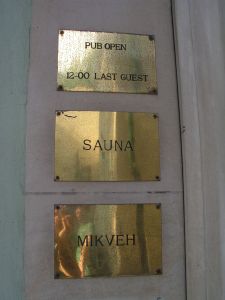
Sign outside the entrance to a fancy hotel in the Jewish Quarter in Krakow. A mikveh is a Jewish ritual bath.

Our Jewish tour guide in Budapest who was extremely well informed and really brought the history to life
IV. Oh little town of Szydłowiec
When the bus dropped us off on the side of the road in Szydlowiec, I wondered if this excursion had been a mistake. We couldn’t see any real town to speak of, just a big empty street with cars whizzing by. The first person we approached to ask for directions didn’t speak any English at all. The next person we talked to said that the one accommodation option listed in Lonely Planet had closed its doors some time ago.
However… We were told there was a nice new hostel right on the edge of town, and the young woman kindly offered to take us there in her car.
Let me just mention here that the Poles generally stuck us as extremely friendly people who went out of their way to help us out on many occasions.
We ended up staying in Szydłowiec for two nights, and we had a lovely time there. Communication with the locals was indeed challenging, but we found ways to make our questions and answers understood, largely with the help of hand signals and by pointing at things.
Once we got our bearings, we were able to appreciate the old town center as well as the local castle which has been repurposed as a museum of traditional Polish folk instruments.
Before the war, the population of Szydlowiec was 70% Jewish. There is hardly any trace of that population left today and there are no Jews living there now other than those who are just passing through.
However, Szydlowiec does have one extraordinary historical gem on display – a huge pre-war Jewish cemetery, virtually unmatched in its size and splendor anywhere else in Eastern Europe.
Over 3,100 tombstones are preserved there, representing just a fraction of the total number that once stood in the cemetery.
The stones are as beautiful as any I’ve ever seen.
A florist around the corner helped us get in touch with a person named Sława who was listed as the relevant contact on a sign at the cemetery entrance. She met us there within the hour and was able to tell us a bit about the history of the cemetery and the Jewish community in Szydłowiec.
Long story short: Jews lived in Szydłowiec beginning in the 16th Century, it was a thriving and successful community right up until WWII, in 1943 all the Jews were rounded up and deported to extermination camps. The End.
Sława is writing a book about Jewish history in Szydłowiec that will be available later this year. When I told her that my family’s name was Grynberg with a “y”, she lit up.
“Yes, there were Grynbergs here! There was a very well known and successful doctor at the hospital named Grynberg. Yes, yes. There were Grynbergs here.”
V. Depravity, death and despair
Though my family escaped the deportations in Poland having moved to France decades earlier, they did not escape deportation altogether.
My grandfather’s mother, father, three younger sisters as well as nieces and nephews were all executed either at Auschwitz or during deportation. No wonder the idea of returning to Poland sounds so distasteful.
James and I decided to visit the Majdanek extermination camp, on the outskirts of a town called Lublin. I had read that Majdanek was particularly well preserved. I also chose to visit Majdanek because I feared a tourist fiasco at Auschwitz would diminish our experience there. James and I even talked about avoiding the concentration camps in Poland completely. It seemed to fall into the strange category of “tragedy tourism” that we had observed in Cambodia. In the end, however, it was only a 20-minute bus ride away.
I will never forget this visit. Never.
I felt very sad but also very proud to be there. Through my tears, I shot images of the camp to show my family.
I don’t feel comfortable including most of the photos I took there in this post, but if you are interested in seeing them you can look through our Poland photo set on Flikr.
78,000 people were exterminated at Majdanek in total, the vast majority of which were Jews. A mere 1,500 were liberated with the arrival of the Red Army in 1943.
Here are a few glimpses into this awful place of depravity, death and despair.
As long as one descendant of European Jews survived to bear witness, the Nazis did not succeed.
VI. Reliving the Alamo
Today was a hard day, the hardest so far in some ways.
I think that after Majdanek I had been holding out a glimmer of hope that the stories of the Warsaw uprisings would renew my faith in power of (some) good people to resist and combat evil. What I came to conclude, instead, was that everyone was out for themselves in World War II and no one gave a shit about the Jews. Excuse my language. Very upsetting.
I did not enjoy the Warsaw Rising Museum.
For those who could use a little background: During World War II, the Nazis and the Soviet Union decided to divvy up and occupy what was previously the Kingdom of Poland. So Poland was no more.
Warsaw was under German rule, and that didn’t sit well with the people of Warsaw. Least of all the Jews who were rounded up and jailed inside the walls of a ghetto with pitifully few resources to support themselves: 400,000 in all, equal to a third of the city’s total population.
Meanwhile, the other residents of Warsaw essentially put up with the Nazi insanity until 1944 when many decided to participate in a massive uprising against their occupiers. They fought an all-out war for about 3 months and had some admirable successes, considering how embarrassingly they were outnumbered and out-resourced. In the end, the uprising was brutally crushed and thousands were jailed, exiled or executed. The City of Warsaw was reduced to smithereens.
Anyway, back to the museum. About 15 minutes after we got there, I said “There’s something that really bothers me about this place.”
It was a familiar feeling, actually. The last time I felt it was when we visited the Alamo in San Antonio, Texas. I’ll explain why in just a minute.
Here are some of the things that really angered me about the exhibits:
1) There was almost no mention made of the Warsaw Ghetto Uprising, which had taken place a year earlier and was the largest display of Jewish resistance anywhere during the entire war;
2) The uprising by the non-Jews had absolutely zero to do with opposing Nazi policies on the extermination of Jews and seemingly everything to do with reestablishing the Kingdom of Poland*;
3) Jews were dismissed in the exhibits either as pathetic victims or as dangerous Communist sympathizers, despite the fact that hundreds had even fought alongside the non-Jews in the 1944 uprising;
4) The liquidation of the Warsaw Ghetto and its inhabitants did not even get included as part of the background or context.
To say that the heroes of the 1944 uprising were glorified at the museum is not saying enough. I would call it outright hagiography. And the tone of the exhibits made it clear that visitors would enthusiastically share that view.
That’s why it reminded me of the Alamo. At the Alamo museum, the Texians were made out to be saints! Meanwhile, they were fighting in defense of the institution of slavery. How was I supposed to admire them? Their whole platform disgusted me.
Perhaps the members of the uprising in Warsaw in 1944 were not fighting in defense of anti-Semitism. But they didn’t seem to be fighting against it, either.
I am sympathetic to the need for Poles to reclaim their dignity after the war and after the Communist era. But that cannot and should not come at the expense of the Jews who have already suffered so greatly.
VII. Parting thoughts
I’ll let you go know, I know this post has been long and drawn out.
There are a few things that I wasn’t able to address that bear mentioning — the horrors of post-war Soviet occupation throughout Eastern Europe which in some ways rivaled and other ways actually dwarfed the Nazi legacy. The extraordinary beauty of Hungarian and Polish folk arts and traditions. The breathtaking historical architecture and pastoral landscapes. The rebirth and renewal that is evident among young people through the region.
James and I welcome your continued postcard requests, and we are looking forward to telling you about our travels in South Bohemia, Czech Republic — one of James’ family’s homelands.
Warm wishes!
* I did find out after we left Poland that members of the Polish resistance were able to liberate the remains of the Warsaw Ghetto as well as the Gęsiówka concentration camp during the uprising, freeing about 350 Jews. I really wish that had been highlighted at the museum.


